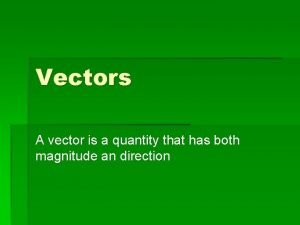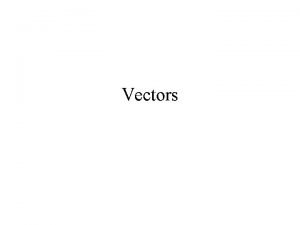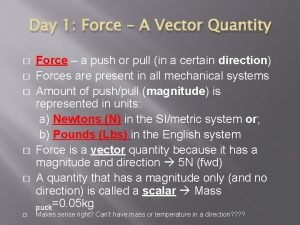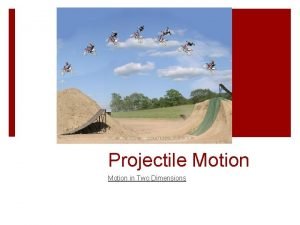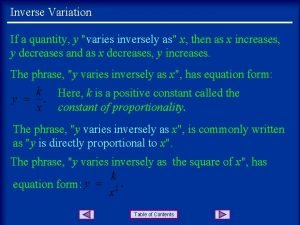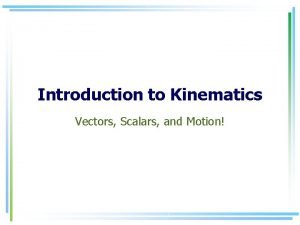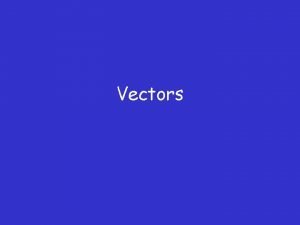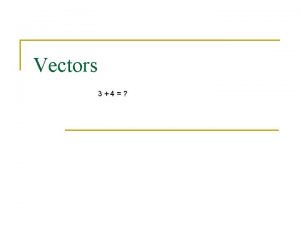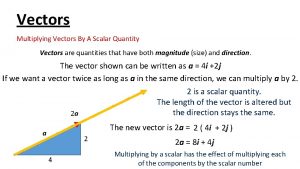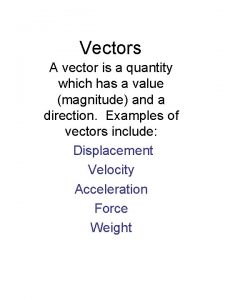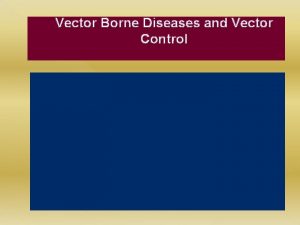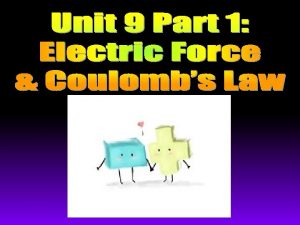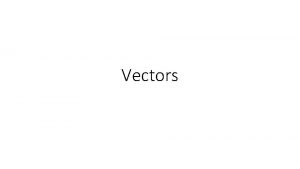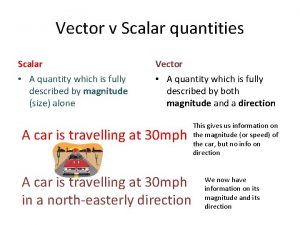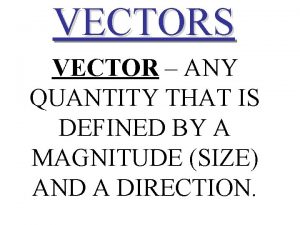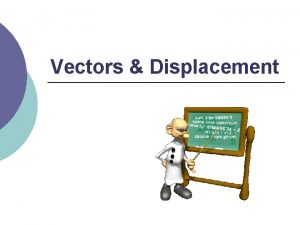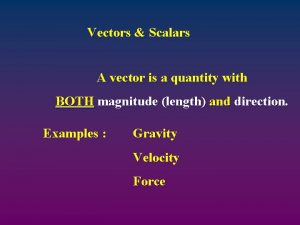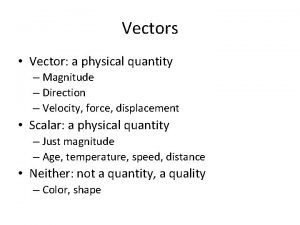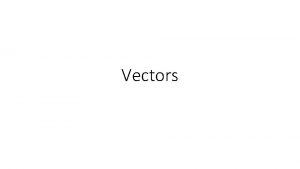Vectors Representing Vectors Vector a quantity that has
























- Slides: 24

Vectors

Representing Vectors • Vector- a quantity that has both magnitude and direction • Graphical Representation: Direction Magnitude

Magnitude to Scale • Scale: 1 cm = 10 m/s The vector measures to be 14 cm long. Therefore the magnitude of the vector is 140 m/s

Magnitude to Scale • Conversely, if we are told that a vector has a magnitude of 75 m/s. Drawing the vector to scale, we would draw an arrow 7. 5 cm long. 7. 5 cm

Assigning Magnitude • A vectors magnitude can also be assigned to a vector with an arbitrary length. 20 m/s

Direction • The direction of vectors along the x or y axis can be denoted by + or -. • Vectors at an angle can be denoted by an angle measurement relative to the axis: 25° above the x-axis 70° below the x-axis or 250°

Direction(continued) • Compass directions can also be used: N 50° W S Stated as: 30 m/s at 50° North of East 30 m/s E or 30 m/s at 40° East of North

Moving Vectors • A vector can be moved anywhere as long as the vector magnitude and direction are preserved

Vector Operations: Addition • When vectors are added together they produce a new vector that represents the sum of the vectors. We call this new vector the resultant.

Adding Parallel Vectors • Adding vectors A and B A = 10 m/s B = 5 m/s • When adding vectors arrange them in headto-tail orientation A+B Resultant = 15 m/s

Commutative Property • Vector Addition is commutative. Two vectors can be added in any order. • A+B=B+A A+B B+A

Adding Vectors at an Angle • Add vectors A and B A = 10 m/s B = 5 m/s • Again arrange vectors in head-to-tail A orientation B

Adding Vectors at an Angle (continued) • The resultant is then drawn from the tail of the first vector to the head of the last vector. A = 10 m/s R B = 5 m/s • Solve by Pythagorean Theorem

Adding Vectors at an Angle (continued) • The angle can then be found using right triangle trigonometry A = 10 m/s R = 11. 2 m/s B = 5 m/s

Adding Vectors at Acute and Obtuse Angles • Add vectors A and B A = 10 m/s B = 5 m/s 30° • Again arrange vectors in head-to-tail A orientation B

Adding Vectors at Acute and Obtuse Angles (continued) • Draw in the resultant A = 10 m/s 120° Determine angle by adding together 90 and 30. B = 5 m/s C • Solve by Law of Cosines

Adding Vectors at Acute and Obtuse Angles (continued) • The angle can then be found using the Law of Sines a = 10 m/s 120° c = 13. 2 m/s b = 5 m/s

Adding Multiple Vectors • Vector Addition is associative. Three vectors can be added in any order. • (a + b) + c = a + (b + c) • Therefore multiple vectors can be added in any order and you will receive the same resultant.

Adding Multiple Vectors (continued) • example B A D C A B R C D E E

Subtracting Vectors • Subtract vectors A and B A = 10 m/s B = 5 m/s • A – B = A + (-B) A A = 10 m/s -B = 5 m/s R R = 5 m/s B

Components of Vectors • For convenience we would like to classify a vector’s direction as pointing in either the x or y directions. • However, this is not obvious for vectors that do not lie along the x or y-axis. • This is why we have a need to describe how much of the vector is projected in the x and y directions. • This is done through the use of components

Components of Vectors (continued) • Given the following vector, determine its components in x and y. v =20 m/s 35° • First, align the vector on a coordinate axis.

Components of Vectors (continued) Project lines from the tip of the vector to produce a rectangle. (green) y v x Extend vectors from the tail of the original vector along the axis until they reach the intersection of the projection. (blue and red)

Components of Vectors (continued) • Each new vector is a vector in either x or y or an x or y component. The components can then be solved for by using right triangle trigonometry. y vy s / m 0 =2 v 35° vx x
 Difference between scalar and vector
Difference between scalar and vector Speed has magnitude only
Speed has magnitude only Scalar quantity and vector quantity
Scalar quantity and vector quantity All examples of vector quantity
All examples of vector quantity Scalar versus vector quantities
Scalar versus vector quantities A vector is a quantity that has
A vector is a quantity that has Adding multiple vectors
Adding multiple vectors Force is a vector quantity because it has both
Force is a vector quantity because it has both Representing vectors
Representing vectors Draw vector arrows representing the vx and vy brainly
Draw vector arrows representing the vx and vy brainly Vary inversly
Vary inversly Sau thất bại ở hồ điển triệt
Sau thất bại ở hồ điển triệt Block nhĩ thất độ 2 mobitz 2
Block nhĩ thất độ 2 mobitz 2 Hãy nói thật ít để làm được nhiều
Hãy nói thật ít để làm được nhiều Thơ thất ngôn tứ tuyệt đường luật
Thơ thất ngôn tứ tuyệt đường luật Tôn thất thuyết là ai
Tôn thất thuyết là ai Chiến lược kinh doanh quốc tế của walmart
Chiến lược kinh doanh quốc tế của walmart Thơ thất ngôn tứ tuyệt đường luật
Thơ thất ngôn tứ tuyệt đường luật Gây tê cơ vuông thắt lưng
Gây tê cơ vuông thắt lưng Phân độ lown ngoại tâm thu
Phân độ lown ngoại tâm thu Tìm độ lớn thật của tam giác abc
Tìm độ lớn thật của tam giác abc Acceleration vector quantity
Acceleration vector quantity Vector quantity
Vector quantity Chapter 5 projectile motion
Chapter 5 projectile motion 5m vector or scalar
5m vector or scalar





